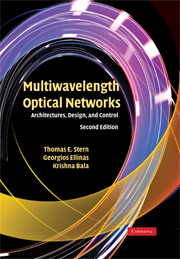Book contents
- Frontmatter
- Contents
- Figures
- Tables
- Preface to the Second Edition
- Acknowledgments
- Multiwavelength Optical Networks
- 1 The Big Picture
- 2 The Layered Architecture and Its Resources
- 3 Network Connections
- 4 Enabling Technology
- 5 Static Multipoint Networks
- 6 Wavelength/Waveband-Routed Networks
- 7 Logically-Routed Networks
- 8 Survivability: Protection and Restoration
- 9 Optical Control Plane
- 10 Optical Packet-Switched Networks
- 11 Current Trends in Multiwavelength Optical Networking
- A Graph Theory
- B Fixed Scheduling Algorithm
- C Markov Chains and Queues
- D A Limiting-Cut Heuristic
- E An Algorithm for Minimum-Interference Routing in Linear Lightwave Networks
- F Synopsis of the SONET Standard
- G A Looping Algorithm
- Acronyms
- Index
A - Graph Theory
Published online by Cambridge University Press: 05 June 2012
- Frontmatter
- Contents
- Figures
- Tables
- Preface to the Second Edition
- Acknowledgments
- Multiwavelength Optical Networks
- 1 The Big Picture
- 2 The Layered Architecture and Its Resources
- 3 Network Connections
- 4 Enabling Technology
- 5 Static Multipoint Networks
- 6 Wavelength/Waveband-Routed Networks
- 7 Logically-Routed Networks
- 8 Survivability: Protection and Restoration
- 9 Optical Control Plane
- 10 Optical Packet-Switched Networks
- 11 Current Trends in Multiwavelength Optical Networking
- A Graph Theory
- B Fixed Scheduling Algorithm
- C Markov Chains and Queues
- D A Limiting-Cut Heuristic
- E An Algorithm for Minimum-Interference Routing in Linear Lightwave Networks
- F Synopsis of the SONET Standard
- G A Looping Algorithm
- Acronyms
- Index
Summary
Graph and hypergraph terminology has evolved over the years. The following definitions are adapted from [Berge89, Bermond+97, Chartrand+96]. Some of the material in this appendix is found in other parts of the book. It is repeated here for convenience.
Graphs
A graph G consists of a set of vertices V(G) and a set of edges E(G), where each edge e is a pair of distinct vertices (u, v). (If the two vertices are the same, then the edge is a loop. We rule out these cases.) A graph with vertex set V and edge set E is typically denoted by G(V, E). If e = (u, v), then u and v are adjacent vertices and e is incident on u and v. Two edges are adjacent if they are incident on the same vertex. Nonadjacent edges or nonadjacent vertices are called independent. A set of pairwise independent vertices of a graph G, which is of maximal cardinality, is called a maximal independent set. Figure A.1 shows an example of a maximal independent set of vertices (outlined in dashed circles).
A graph in which every two vertices are adjacent is called a complete or fully connected graph. The complete graph with n vertices is denoted by Kn. Figure A.2 shows K5.
A graph G is called bipartite if its vertices can be partitioned into two subsets, V1 and V2, (called partite sets) such that every edge of G joins a vertex in V1 to one in V2.
- Type
- Chapter
- Information
- Multiwavelength Optical NetworksArchitectures, Design, and Control, pp. 869 - 878Publisher: Cambridge University PressPrint publication year: 2008

